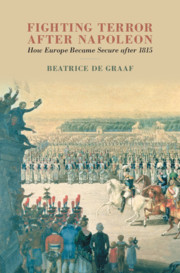Book contents
- Fighting Terror after Napoleon
- Fighting Terror after Napoleon
- Copyright page
- Contents
- Figures
- Maps
- Tables
- Acknowledgements
- Prologue
- 1 Introduction
- 2 Providence in Paris
- 3 Balancing in a Climate of Distress
- 4 ‘A Moderate Occupation’
- 5 Fausses nouvelles and ‘Blacklists’
- 6 Fighting terroristes Together
- 7 The Price of Security
- 8 Fortress Europe
- 9 Beyond Europe
- 10 Conclusion
- Bibliography
- Index
3 - Balancing in a Climate of Distress
Published online by Cambridge University Press: 12 September 2020
- Fighting Terror after Napoleon
- Fighting Terror after Napoleon
- Copyright page
- Contents
- Figures
- Maps
- Tables
- Acknowledgements
- Prologue
- 1 Introduction
- 2 Providence in Paris
- 3 Balancing in a Climate of Distress
- 4 ‘A Moderate Occupation’
- 5 Fausses nouvelles and ‘Blacklists’
- 6 Fighting terroristes Together
- 7 The Price of Security
- 8 Fortress Europe
- 9 Beyond Europe
- 10 Conclusion
- Bibliography
- Index
Summary
After the second victory against Napoleon, Allied deliberations about peace and security were inevitably juxtaposed with the threat of ‘terror’. The threat of new revolutions and the rise of new despots like Napoleon loomed over the Allies, leading to the concept of ‘balance of power’ being used in a normative context: notions of peace, tranquillity and harmony were not only principles of politics, but expressions of a collective sentiment that bonded the European community of statesmen together. The ‘balance of power’ was also a hierarchical principle, as it served to reorder the map of Europe and of the world beyond it, and smaller nations were at the mercy of the four powers and their decision-making. More a guiding principle than a concrete set of policies, the ‘balance of power’ represented a collective desire for peace and security in Europe, but the statesmen had to implement and order that balance and peace on a daily basis, in a time of distress and transformation.
- Type
- Chapter
- Information
- Fighting Terror after NapoleonHow Europe Became Secure after 1815, pp. 93 - 137Publisher: Cambridge University PressPrint publication year: 2020

